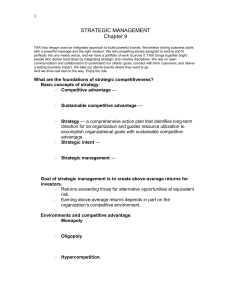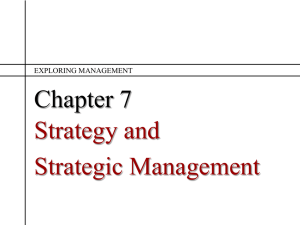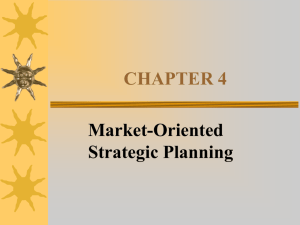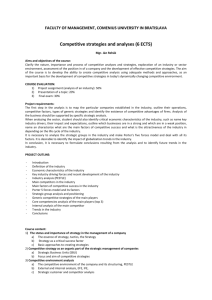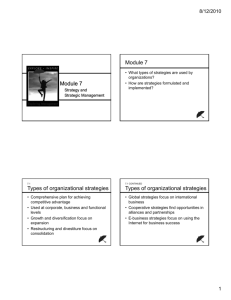chapter 7 - MissIfe-BOH4M-SOC
advertisement
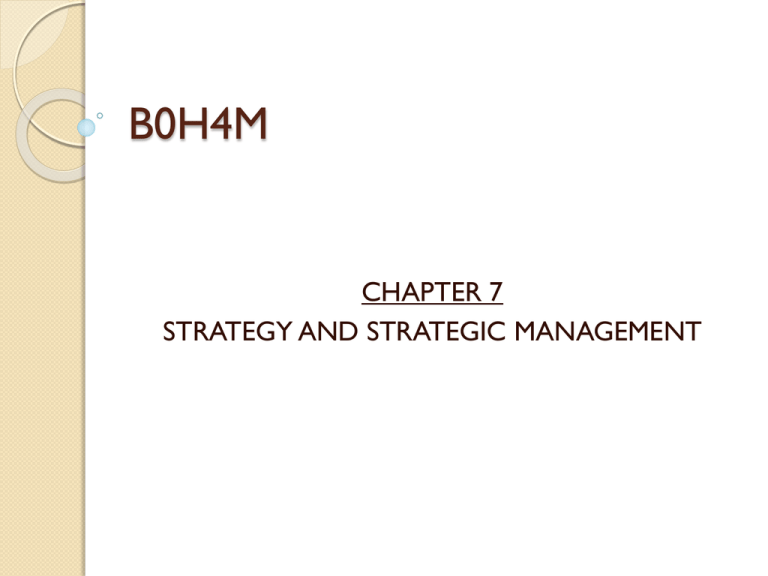
B0H4M CHAPTER 7 STRATEGY AND STRATEGIC MANAGEMENT OVERVIEW What is strategic management? What are the essentials of strategic analysis? What are the corporate strategies and how are they formulated? What are business strategies and how are they formulated? What are some current issues in strategy implementation? What Is Strategic Management? Competitive Advantage Sustainable Competitive Advantage Strategy Strategic Intent Goal of strategic management is to create above-average returns for investors. ◦ Returns exceeding those for alternative opportunities at equivalent risk. ◦ Earning above-average returns depends in part on the organization’s competitive environment. What Is Strategic Management? STRATEGIC MANAGEMENT PROCESS Strategic Management Strategic Analysis Strategy Formulation Strategy Implementation Figure 7.2 Strategy formulation and implementation in the strategic management process. Management 2e - Chapter 7 5 ESSENTIALS OF STRATEGIC ANALYSIS Mission – Statement expresses the organization’s reason for existence in society An important test of the mission is how well it serves the organization’s stakeholders Figure 7.3 How external stakeholders can be valued as strategic constituencies of organizations. Management 2e - Chapter 7 7 ESSENTIALS OF STRATEGIC ANALYSIS Core Values Organizational Culture ESSENTIALS OF STRATEGIC ANALYSIS Analysis of objectives: ◦ Operating objectives direct activities toward key and specific performance results. ◦ Typical operating objectives: Profitability Market share Human talent Financial health Cost efficiency Product quality Innovation Social responsibility Management 2e - Chapter 7 9 ESSENTIALS OF STRATEGIC ANALYSIS What are our Strengths? ◦ Manufacturing efficiency? ◦ Skilled workforce? ◦ Good market share? ◦ Strong financing? ◦ Superior reputation? What are our Weaknesses ◦ Outdated facilities? ◦ Inadequate research and development? ◦ Obsolete technologies? ◦ Weak management? ◦ Past planning failures? Management 2e - Chapter 7 10 ESSENTIALS OF STRATEGIC ANALYSIS What are our Opportunities? • Possible new markets? • Strong economy? • Weak market rivals? • Emerging technologies? • Growth of existing market? What are our Threats? • New competitors? • Shortage of resources? • Changing market tastes? • New regulations? • Substitute products? Figure 7.4 SWOT analysis of strengths, weaknesses, opportunities, and threats. Management 2e – Chapter 7 12 Figure 7.5 Porter’s model of five strategic forces affecting industry competition. Source: Developed from Michael E. Porter, Competitive Strategy (New York: Free Press, 1980). Management 2e - Chapter 7 13 Corporate Strategy Levels of strategies ◦ Corporate strategy sets long-term direction for the total enterprise ◦ Business strategy identifies how a division or strategic business unit will compete in products or services ◦ Functional strategy guides activities within one specific area of operations Figure 7.1 Three levels of strategy in organizations- corporate, business, functional strategies. Management 2e - Chapter 7 15 Corporate Strategy Grand or master strategies: ◦ Growth strategies: seek an increase in size and the expansion of current operations. ◦ Stability strategy: maintains current operations without substantial changes ◦ Renewal strategy: tries to solve problems and overcome weaknesses that are hurting performance. ◦ Combination strategy: pursues growth, stability, or retrenchment in some Corporate Strategy Growth and diversification strategies: ◦ Growth strategies Seek an increase in size and the expansion of current operations. ◦ Types of growth strategies: Concentration strategies Diversification strategies Related diversification Unrelated diversification Vertical integration Corporate Strategy Restructuring strategies: ◦ Tries to correct weaknesses by changing the mix or reducing the scale of operations. Restructuring through turnaround Restructuring through downsizing Restructuring through divestiture Corporate Strategy Global strategies: ◦ Globalization strategy. World is one large market; standardize products and advertising as much as possible. Ethnocentric view. ◦ Multidomestic strategy. Customize products and advertising to local markets as much as possible. Polycentric view. ◦ Transnational strategy. Balance efficiencies in global operations and responsiveness to local markets. Geocentric view. Corporate Strategy Cooperative strategies ◦ Strategic alliances — two or more organizations partner to pursue an area of mutual interest. ◦ Types of strategic alliances: Outsourcing alliances Supplier alliances Distribution alliances Co-opetition Corporate Strategy E-business strategies ◦ The strategic use of the Internet to gain competitive advantage. ◦ Popular e-business strategies Business-to-business (B2B) strategies Business-to-customer (B2C) strategies Business-level Strategy Porter’s generic strategies model ◦ Business-level strategic decisions are driven by: Market scope Source of competitive advantage ◦ Market scope and source of competitive advantage combine to generate four generic strategies. Figure 7.7 Porter’s generic strategies framework: softdrink industry examples. Management 2e - Chapter 7 23 Business-level Strategy Porter’s generic strategies for gaining competitive advantage: ◦ Differentiation strategy ◦ Cost leadership strategy ◦ Focused differentiation strategy ◦ Focused cost leadership strategy Strategy Implementation Strategic planning failures that hinder strategy implementation: ◦ Failures of substance Inadequate attention to major strategic planning elements ◦ Failures of process Poor handling of strategy implementation Lack of participation error Goal displacement error Strategy Implementation Corporate governance: ◦ System of control and performance monitoring of top management. ◦ Done by boards of directors and other major stakeholder representatives. ◦ Controversies regarding roles of inside directors and outside directors. ◦ Increasing emphasis on corporate governance in contemporary businesses. Strategy Implementation Strategic control ◦ Making sure strategies are well implemented and that poor strategies are scrapped or modified. ◦ The top leadership of a firm or organization is expected to exercise strategic control of the enterprise. Strategy Implementation Strategic leadership ◦ The capability to inspire people to successfully engage in a process of continuous change, performance enhancement, and implementation of organizational strategies. Strategy Implementation Critical tasks of strategic leadership ◦ Be a guardian of trade-offs. ◦ Create a sense of urgency. ◦ Ensure that everyone understands the strategy. ◦ Be a teacher. Review Can an organization have a good strategy and still fail to achieve competitive advantage? Would a monopoly get a perfect score for in
